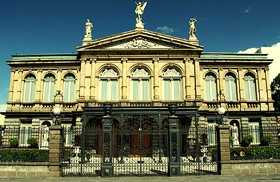
The National Theatre of Costa Rica is a nation’s pride, an architectural feat, a timeless jewel and a withstanding monument. It is said to be the creation of the outpouring hearts and efforts of Costa Ricans who wanted nothing more than to house cultural and theatrical acts, operas as well as other staged performances.
History
Believe it or not, coffee growers are the ones who initiated the building of this theater in the year 1891. These rich entrepreneurs self-imposed taxes one each bags of coffee they produce in pursuit of having their very own venue to house events of all sorts. But the construction of the National Theatre did not come easy.
Imposing taxes upon their own businesses entailed higher coffee prices and controversies soon surrounded the government. But it did not stop these businessmen to reach their goal. Soon enough, their desire became contagious and teachers, artists, artisans, merchants of different kinds as well as students and housewives all donated to make this architectural dream come true.
After a pain-staking 6 years of hard work, endless persistence and a tremendous amount of donations and funds, the National Theatre was finally opened to the public on October 21, 1897 with an opening performance of Johann Wolfgang von Goethe’s Faust.
Unfortunately, the National Theater had to close its doors when the devastating earthquake of 1991 hit the country, severely damaging it. But these theatre enthusiasts weren’t about to give up. They rebuilt it once again and come year 1993, it was again opened for everyone.
The Real Push to Build
The Costa Ricans were offended when theatrical groups locally and internationally refused to perform in “little theaters” which greatly affected the people of the country and its chance of strengthening its tourism. What was even more offensive and hurtful for the Costa Rican was when famous diva at the time Adelina Patti refused to stage any of her performances in front of the public in a “small theatre of varieties”.
These criticisms were taken constructively by the Costa Ricans–literally. After the incident, they vowed to make a national theater of their own were legendary performances will be made and the structure itself will forever be known as a Costa Rican milestone.
Design and Structure
The main architectural style incorporated to build the National Theater was neo-classical. Public Works’ Director Engineer Nicolás Chavarría re-designed the building in such a way that it will be strong enough to withstand earthquakes but still maintain its divine beauty and mesmerizing presence. Metal columns stuffed with bricks were built and were soon polished so as not to make it look like a cage.
The front of the theatre showcases statues of Calderón de la Barca and Ludwig van Beethoven while the inside’s ceiling is adorned by the Allegory of Coffee and Bananas by Milanese artist Aleardo Villa–paying tribute to the coffee growers who pioneered the construction and the bananas as one of the principal product of trade in Costa Rica.
Located in the heart of San Jose–Costa Rica’s capital, the National Theatre continues to stand tall, proud and iconic. Locals and tourists alike never fail to be amazed by the country’s declared national monument and it surely is one place you shouldn’t miss when you set foot in Costa Rica.
| Getting There
The National Theater is not hard to miss. It is right next to the south side of Plaze de la Cultura in the heart of San Jose. It is in Avenida 2, Calle 3/5. Buses from all over the capital can drop you off there. Private charters from your hotels can pick you up and take you there. |
| Places to Stay Near Rainmaker |

Comments are closed.